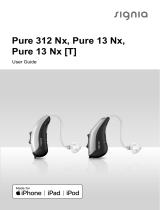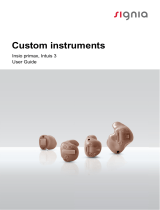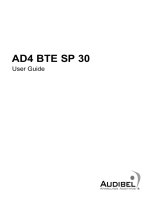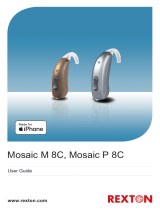Page is loading ...

Run P / SP
Fun P / SP
Fa P
User Guide

2
Content
Welcome 4
Your hearing inruments 5
Inrument type 5
Getting to know your hearing inruments 5
Components and names 6
Batteries 9
Battery size and handling tips 9
Replacing batteries 10
Daily use 11
Turning on and o 11
Inserting and removing the hearing inruments 12
Adjuing the volume 14
Maintenance and care 15
Hearing inruments 15
Ear pieces, earhooks and tubes 16
Professional maintenance 20

4
Welcome
Thank you for choosing our hearing inruments to
accompany you through everyday life. Like anything new,
it may take you a little time to become familiar with them.
This guide, along with support from your Hearing Care
Professional, will help you underand the advantages
and greater quality of life your hearing inruments oer.
To receive the mo benet from your hearing
inruments, it is recommended that you wear them every
day, all day. This will help you get adjued to them.
CAUTION
It is important to read this user guide and the safety
manual thoroughly and completely. Follow the
safety information to avoid damage or injury.

5
Your hearing inruments
Inrument type
Your hearing inruments are BTE (Behind-The-Ear)
models. A tube delivers the sound from the hearing
inrument into the ear. The inruments are not intended
for children under the age of 3 years or persons with a
developmental age of under 3 years.
Your hearing inruments have pre-congured sound
proles. Your Hearing Care Professional has set the
appropriate sound prole for you.
Getting to know your hearing inruments
It is recommended to familiarize yourself with your new
hearing inruments. With the inruments in your hand
try using the controls and note their location on the
inrument. This will make it easier for you to feel and
press the controls while wearing the hearing inruments.

6
Components and names
This user guide describes several types of hearing
inruments. Use the following pictures to identify the type
of hearing inrument that you use.
Run P, Fun P Run SP, Fun SP
➊ Ear piece
➋ Adapter for ear piece
➌ Tube for earhook
➍ Earhook
➎ Microphone openings
➏ Second microphone
(Run P only)
➐ Rocker switch (control)
➑ Battery compartment
(on/o switch)

7
Fa P
➊ Ear piece
➋ Adapter for ear piece
➌ Tube for earhook
➍ Earhook
➎ Microphone openings
➏ Rocker switch (control)
➐ Battery compartment
(on/o switch)

8
Ear pieces
Standard ear pieces Size
Cuom-made ear pieces
Examples:
You can easily exchange the andard ear pieces.
Read more in section "Maintenance and care".

9
Batteries
When the battery is low the sound becomes weaker
or you will hear an alert signal. The battery type will
determine how long you have to replace the battery.
Battery size and handling tips
Ask your Hearing Care Professional for recommended
batteries.
Battery size: 13 675
● Always use the correct battery size for your hearing
inruments.
● Remove the batteries if you intend not to use the
hearing inruments for several days.
● Always carry spare batteries.
● Remove empty batteries immediately and follow your
local recycling rules for battery disposal.

10
Replacing batteries
Removing the battery:
XOpen the battery compartment.
XPush the battery out
(refer to the picture).
Inserting the battery:
XIf the battery has a protective lm, remove it
only when you are ready to use the battery.
XInsert the battery with the "+" symbol
facing up (refer to the picture).
XCarefully close the battery compartment. If you feel
resiance, the battery is not inserted correctly.
Do not attempt to close the battery compartment by
force. It can be damaged.

11
Daily use
Turning on and off
You have the following options to turn your hearing
inruments on or o.
Via battery compartment:
XTurning o: Open the battery
compartment fully.
XTurning on: Close the battery compartment.
The hearing inruments turn on after a delay of
several seconds. During this time you can insert the
hearing inruments into your ears without experiencing
unpleasant feedback whiling.

12
Inserting and removing the hearing inruments
Your hearing inruments have been ne-tuned for
your right and left ear. Colored markers
indicate the side:
● red marker = right ear
● blue marker = left ear
Inserting a hearing inrument:
XHold the tube close to the ear piece.
XCarefully push the ear piece
into the ear canal ➊.
XTwi it slightly until it sits
well.
Open and close your mouth
to avoid accumulation of air
in the ear canal.
XLift the hearing inrument
and slide it over the top of
your ear ➋.
CAUTION
Risk of injury!
XInsert the ear piece carefully and not too deeply
into the ear.

13
● It may be helpful to insert the right hearing
inrument with the right hand and the left
hearing inrument with the left hand.
● If you have problems inserting the ear piece,
use the other hand to gently pull your earlobe
downwards. This opens the ear canal and eases
insertion of the ear piece.
Removing a hearing inrument:
XLift the hearing inrument
and slide it over the top of
your ear ➊.
XHold the tube close to
the ear piece and pull the
ear piece out carefully ➋.
CAUTION
Risk of injury!
XIn very rare cases the ear piece could remain in
your ear when removing the hearing inrument.
If this happens, have the ear piece removed by
a medical professional.
Clean and dry your hearing inruments after usage.
Read more in section "Maintenance and care".

14
Adjuing the volume
Your hearing inruments automatically adju the volume
to the liening situation.
XIf you prefer manual volume adjument, press the
rocker switch briey.
A signal tone indicates the volume change. Once the
maximum or minimum volume level has been reached,
you will hear a dierent signal tone. Depending on the
hearing inrument type, you will also hear a signal tone
for the default volume level.
If you turn o the hearing inruments immediately
after changing the volume, the volume change may
not be saved. Wait 5 seconds before turning the
hearing inruments o.

15
Maintenance and care
To prevent damage it is important that you take care of
your hearing inruments and follow a few basic rules,
which will soon become a part of your daily routine.
Hearing inruments
Drying and orage
XDry your hearing inruments overnight.
XAsk your Hearing Care Professional for recommended
drying products.
XFor longer periods of non-use, ore your hearing
inruments with open battery compartment and
batteries removed in a drying syem to avoid the
adverse eects of moiure.
Cleaning
Your hearing inruments have a protective coating.
However, if not cleaned regularly you may damage the
hearing inruments or cause personal injury.
XClean your hearing inruments daily with a soft, dry
tissue.
XNever use running water or immerse the
devices in water.
XNever apply pressure while cleaning.

16
XAsk your Hearing Care Professional for recommended
cleaning products, special care sets, or more
information on how to keep your hearing inruments
in good condition.
Ear pieces, earhooks and tubes
Cerumen (ear wax) may accumulate on the ear pieces.
This may aect sound quality. Clean the ear pieces daily.
● For hearing inruments with a andard ear piece:
Exchange the ear pieces approximately every three
to six months, or sooner if you notice cracks or other
changes.
Ask your Hearing Care Professional to clean the tubes
or to exchange tubes as needed.
● For hearing inruments with cuom-made ear pieces:
Ask your Hearing Care Professional to clean the tubes
or to exchange the ear pieces and tubes as needed.
Exchange the earhook if you notice cracks or other
changes.

17
Cleaning ear pieces
XClean the
ear piece upon
removal with
a soft and dry
tissue.
This prevents
cerumen
becoming dry
and hardening.
XNever use running water or immerse the ear piece in
water.

18
Exchanging andard ear pieces
XPull o the used ear piece and plug on the new
ear piece.
Run P/SP, Fun P/SP:
ᆼ
ᆻ
ᆺ
Fa P:

19
Exchanging earhooks
XUnscrew the used earhook.
XPosition the earhook on the thread as shown in
picture ➊.
XGently screw on the earhook with six full turns ➋.
If you feel resiance from the opper ➌, op turning
to prevent damage.
6x

20
Professional maintenance
Your Hearing Care Professional can perform a thorough
professional cleaning and maintenance.
Cuom-made ear pieces and wax lters should
be exchanged as needed by your Hearing Care
Professional.
Ask your Hearing Care Professional for your individual
recommendation of maintenance intervals and for
support.
/



















